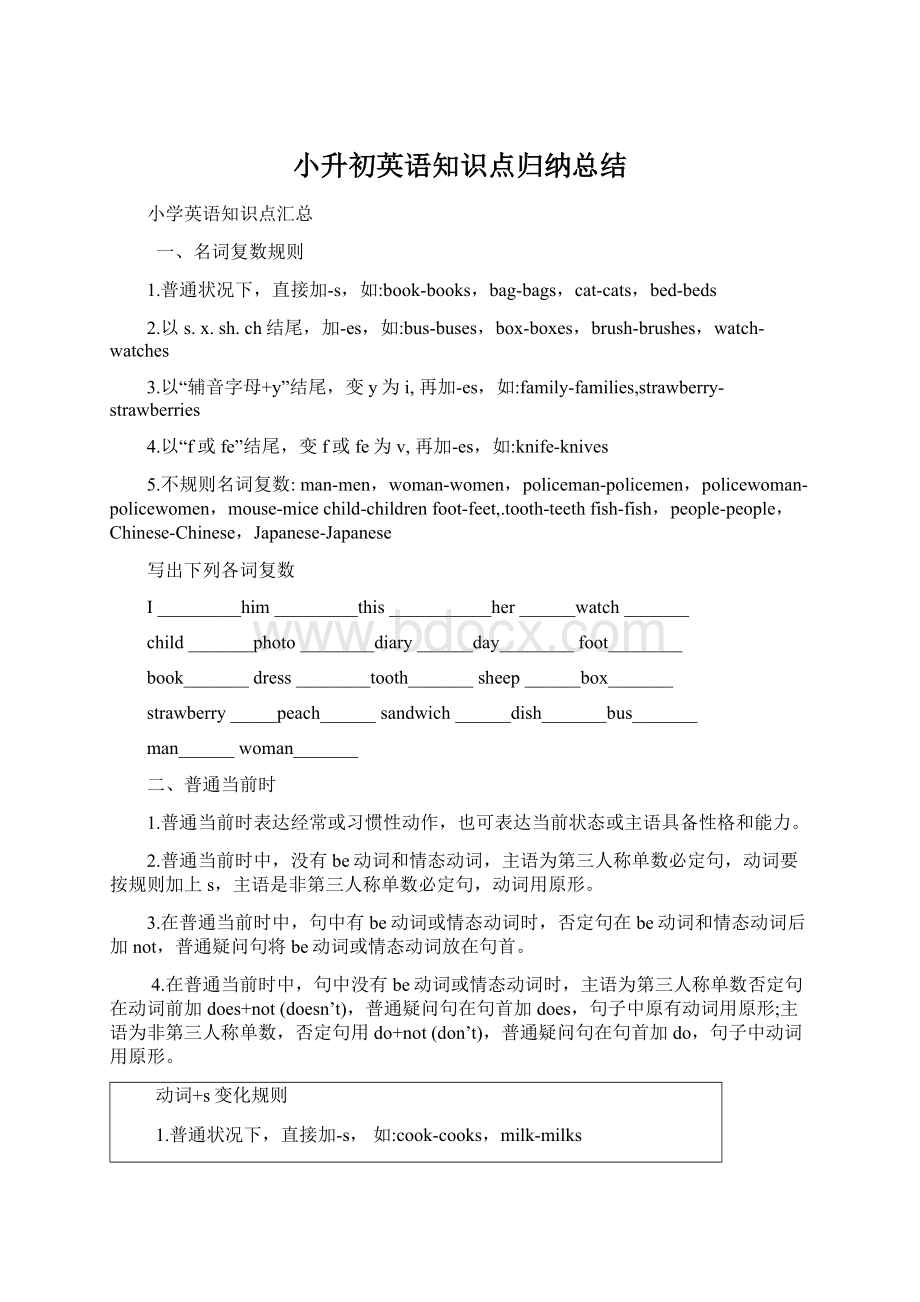小升初英语知识点归纳总结Word格式.docx
《小升初英语知识点归纳总结Word格式.docx》由会员分享,可在线阅读,更多相关《小升初英语知识点归纳总结Word格式.docx(11页珍藏版)》请在冰豆网上搜索。

普通当前时基本用法简介
【No.1】普通当前时功能
1.表达事物或人物特性、状态。
如:
Theskyisblue.天空是蓝色。
2.表达经常性或习惯性动作。
Igetupatsixeveryday.我每天六点起床。
3.表达客观现实。
Theearthgoesaroundthesun.地球绕着太阳转。
普通当前时构成
1.be动词:
主语
be(am,is,are)
其他。
Iamaboy.我是一种男孩。
2.行为动词:
行为动词(
其他)。
WestudyEnglish.咱们学习英语。
当主语为第三人称单数(he,she,it)时,要在动词后加"
-s"
或"
-es"
。
MarylikesChinese.玛丽喜欢汉语。
【No.2】普通当前时变化
1.be动词变化。
否定句:
benot
Heisnotaworker.她不是工人。
普通疑问句:
Be
-Areyouastudent?
-Yes.Iam./No,I'
mnot.
特殊疑问句:
疑问词
普通疑问句。
Whereismybike?
2.行为动词变化。
don'
t(doesn'
t)
动词原形(
Idon'
tlikebread.
当主语为第三人称单数时,要用doesn'
t构成否定句。
Hedoesn'
toftenplay.
Do(Does)
动词原形
-Doyouoftenplayfootball?
-Yes,Ido./No,Idon'
t.
当主语为第三人称单数时,要用does构成普通疑问句。
-Doesshegotoworkbybike?
-Yes,shedoes./No,shedoesn'
动词
s变化规则
2.以s.x.sh.ch.o结尾,加-es,
3.以“辅音字母
y”结尾,变y为i,
用括号内动词恰当形式填空。
1.Heoften________(have)dinnerathome.
2.DanielandTommy_______(be)inClassOne.
3.We_______(notwatch)TVonMonday.
4.Nick_______(notgo)tothezooonSunday.
5.______they________(like)theWorldCup?
6.What_______theyoften_______(do)onSaturdays?
7._______yourparents_______(read)newspaperseveryday?
8.Thegirl_______(teach)usEnglishonSundays.
9.SheandI________(take)awalktogethereveryevening.
10.There________(be)somewaterinthebottle.
11.Mike_______(like)cooking.
12.They_______(have)thesamehobby.
13.Myaunt_______(look)afterherbabycarefully.
14.Youalways_______(do)yourhomeworkwell.
15.I_______(be)ill.I’mstayinginbed.
16.She_______(go)toschoolfromMondaytoFriday.
17.LiuTao_______(do)notlikePE.
18.Thechildoften_______(watch)TVintheevening.
19.SuHaiandSuYang_______(have)eightlessonsthisterm.
20.
-Whatday_______(be)ittoday?
-
It’sSaturday
三、当前进行时
1.当前进行时表达当前正在进行或发生动作,也可表达当前一段时间内活动或现阶段正在进行动作。
2.当前进行时必定句基本构造为be+动词ing.
3.当前进行时否定句在be后加not。
4.当前进行时普通疑问句把be动词调到句首。
5.当前进行时特殊疑问基本构造为:
疑问词+
be+主语+
动词ing?
动词加ing变化规则
1.普通状况下,直接加ing,如:
cook-cooking
2.以不发音e结尾,去e加ing,如:
make-making,taste-tasting
3.如果末尾是一种元音字母和一种辅音字母,双写末尾辅音字母,再加ing,如:
run-running,stop-stopping
写出下列动词当前分词:
play________run__________swim_________make__________
go_________like________write_________ski___________
read________have_________sing________dance_________
put_________see________buy_________love____________
live_______take_________come________get_________
stop_________sit________begin________shop___________
二、用所给动词对的形式填空:
1.Theboy__________________(draw)apicturenow.
2.Listen.Somegirls_______________(sing)intheclassroom.
3.Mymother_________________(cook)somenicefoodnow.
4.What_____you______(do)now?
5.Look.They_______________(have)anEnglishlesson.
6.They____________(not,water)theflowersnow.
7.Look!
thegirls________________(dance)intheclassroom.
8.Whatisourgranddaughterdoing?
She_________(listen)tomusic.
9.It’s5o’clocknow.We_____________(have)suppernow
10.______Helen____________(wash)clothes?
Yes,sheis.
四、将来时理论及练习
一、概念:
表达将要发生动作或存在状态及打算、筹划或预备做某事。
句中普通有如下时间状语:
tomorrow,nextday(week,month,year…),soon,thedayaftertomorrow(后天)等。
二、基本构造:
①begoingtodo;
②willdo.
三、否定句:
在be动词(am,is,are)l后加not或情态动词will后加not成won’t。
例如:
I’mgoingtohaveapicnicthisafternoon.→I’mnotgoingtohaveapicnicthisafternoon.
四、同义句:
begoingto=will
1.begoingto
表达将要发生事或打算、筹划、决定要做事情。
2.必定句:
begoingto+动词原形,
Jimisgoingtoplayfootball.
benotgoingto+动词原形,如:
Jimisnotgoingtoplayfootball.
把be动词调到句首,如:
IsJimgoingtoplayfootball?
疑问词+be+主语+goingto+动词原形?
WhatisJimgoingtodo?
疑问词当主语时:
疑问词+be+goingto+动词原形?
Whoisgoingtoplayfootball?
Iamgoingtogoswimmingtomorrow(明天).=Iwillgoswimmingtomorrow.
练习:
填空。
1.
我打算明天和朋友去野炊。
I_____________________haveapicnicwithmyfriends.
I________haveapicnicwithmyfriends.
2.咱们将要学习英语
We_____________________learnEnglish.
We________learnEnglish.
五、普通过去时
1.普通过去时表达过去某个时间发生动作或存在状态,常和表达过去时间状语连用。
普通过去时也表达过去经常或重复发生动作感谢。
2.Be动词在普通过去时中变化:
⑴am
和is在普通过去时中变为was。
(wasnot=wasn’t)
⑵are在普通过去时中变为were。
(werenot=weren’t)
⑶带有was或were句子,其否定、疑问变化和is,am,are同样,即否定句在was或were后加not,普通疑问句把was或were调到句首。
3.句中没有be动词普通过去时句子
didn’t+动词原形,如:
Jimdidn’tgohomeyesterday.
在句首加did,句子中动词过去式变回原形。
DidJimgohomeyesterday?
⑴疑问词+did+主语+动词原形?
WhatdidJimdoyesterday?
⑵疑问词当主语时:
疑问词+动词过去式?
Whowenttohomeyesterday?
动词过去式变化规则:
1.普通在动词末尾加-ed,如:
pull-pulled,cook-cooked
2.结尾是e加d,如:
taste-tasted
3.末尾只有一种元音字母和一种辅音字母重读闭音节,应双写末尾辅音字母,再加-ed,(辅+元+辅)如:
stop-stopped
4.以“辅音字母+y”结尾,变y为i,再加-ed,如:
study-studied
5.不规则动词过去式:
am,is-was,are-were,do-did,see-saw,say-said,give-gave,get-got,go-went,come-came,have-had,eat-ate,take-took,run-ran,sing-sang,put-put,make-made,read-read,write-wrote,draw-drew,drink-drank,fly-flew,ride-rode,speak-spoke,sweep-swept,swim-swam,sit-sat
过去时练习
写出下列动词过去式
is\am_________plant________are________
drink_________play_______go________make________
does_________dance________worry________ask_____
taste_________eat__________put______
kick_________pass_______do________
Be动词过去时练习
(1)
Name____________No.______Date__________
用be动词恰当形式填空
1.I_______atschooljustnow.
2.He________atthecamplastweek.
3.We________studentstwoyearsago.
4.They________onthefarmamomentago.
5.YangLing________elevenyearsoldlastyear.
6.There________anappleontheplateyesterday.
7.There________somemilkinthefridgeonSunday.
8.Themobilephone_______onthesofayesterdayevening.
1.I______anEnglishteachernow.
2.She_______happyyesterday.
3.They_______gladtoseeeachotherlastmonth.
行为动词过去时练习
(2)
1.I______(watch)acartoononSaturday.
2.Herfather_______(read)anewspaperlastnight.
3.We_________tozooyesterday,we_____tothepark.(go)
4.______you_______(visit)yourrelativeslastSpringFestival?
5.______he_______(fly)akiteonSunday?
Yes,he______.
6.GaoShan_______(pull)upcarrotslastNationalDayholiday.
7.I____________(sweep)theflooryesterday,butmymother______.
8.What______she_______(find)inthegardenlastmorning?
She__________(find)abeautifulbutterfly.
(二)小升初英语词类:
动词、名词和形容词不太容易区别,如不能一眼看出,可用如下办法:
先用“一(量词)”(如:
一种、一张等)和这个词连起来说,如说得通,普通以为是名词;
说不通再用“很”去判断,就是把“很”和为个词连起来说,说得通普通就是形容词;
都说不通就是动词。
(当前咱们学过,后来也许不同)(此外某些很明显,如人称代词、数词、情态动词等一下就可以懂得)
1、动词
这里所说动词是指各种动词总称,其中涉及行为动词(就是咱们平时总说那种动词)、be动词、情态动词。
(1)行为动词
就是咱们平时上学时说动词,表达某一动作或行为。
sweep、live等。
行为动词咱们已学过它们四种形式:
原形、+s/es、+ed、+ing,详细判断办法如下:
↗有,就加ing
读句子→读该单词→结识该单词→理解意思→看有无be动词
(若是begoingto
就用原形)
↘没有,再看情态动词
↗有,就用原形
↗有,就加ed
↘没有,再看有无表达过去时间状语
↗是第三人称单数就加s或es
↘没有,再看主语
↘不是第三人称单数就用原形
(2)be动词
a、Am--wasIs--wasAre--were
口诀:
我用am,
你用are,is用她她它,所有复数全用are。
b、必定和否定句
Iam(not)fromLondon.Heis(not)ateacher.
Sheis(not)inthediningroom.
Myhairis(not)long.Hereyesare(not)small.
c、普通疑问句
AmIaChinese?
Yes,youare.No,youaren’t.
AretheyAmerican?
Yes,theyare.No,theyaren’t.
Isthecatfat?
Yes,itis.No,itisn’t.
咱们当前学过be动词大体分两类:
is、am、are为一类,
普通用于普通当前时、当前进行时和普通将来时中,was和were为另一类,普通用于普通过去时。
判断环节:
↗第一、三人称单数,就用was
↗有,再看人称
↘第二人称单数和所有复数,就用were
看有无表达过去时间状语
↗第一人称单数,就用am
↘没有,再看人称→第三人称单数,就有is
↘第二人称单数和所有复数,就用are
用am,is,are
填空
1.I______aboy.______youaboy?
No,I_____not.
2.Thegirl______Jack'
ssister.
3.Thedog_______tallandfat.
4.Themanwithbigeyes_______ateacher.
5.______yourbrotherintheclassroom?
6.Where_____yourmother?
She______athome.
7.How_______yourfather?
8.MikeandLiuTao______atschool.
9.Whosedress______this?
10.Whosesocks______they?
(3)情态动词
情态动词也是一类特殊动词,平时咱们不把它说成是动词。
情态动词可以和行为动词同步出当前同一种句子中。
咱们当前学过情态动词有:
can、must、should、would、may。
接触最多是can。
情态动词后动词总是用原形。
(不受其她任何条件影响)
2、名词
表达某一事物,有详细和抽象之分。
判断核心词往往是be动词,be动词如果是am、is或was,名词就用原形;
be动词如果是are或were,名词就加s或es。
这里强调两点:
不可数名词都默以为单数,因此总是用is或者was;
最佳不要依照some、any、alotof等词去作判断,以免受误导。
如何加后缀:
a.普通状况下,直接加-s,如:
b.以s.x.sh.ch结尾,加-es,如:
c.以“辅音字母+y”结尾,变y为i,
family-families,strawberry-strawberries
d.以“f或fe”结尾,变f或fe为v,
knife-knives
e.不规则名词复数:
man-men,woman-women,policeman-policemen,policewoman-policewomen,mouse-micechild-childrenfoot-feet,.tooth-teethfish-fish,people-people,Chinese-Chinese,Japanese-Japanese
↗如是am、is或was→原形读句子→读该单词→结识该单词→理解意思→看be动词
↘